ACCT6006 Auditing: Risk Assessment, Materiality & Evidence Analysis
VerifiedAdded on 2023/06/13
|8
|2211
|51
Report
AI Summary
This report provides a detailed analysis of audit risk assessment, materiality, and audit evidence within the context of Auditing Theory and Practice (ACCT6006). It identifies inherent risks at MaxSecurity Limited, focusing on potential fraud, costing system implementation risks, and information...

qwertyuiopasdfghjklzxcvbnmqwertyui
opasdfghjklzxcvbnmqwertyuiopasdfgh
jklzxcvbnmqwertyuiopasdfghjklzxcvb
nmqwertyuiopasdfghjklzxcvbnmqwer
tyuiopasdfghjklzxcvbnmqwertyuiopas
dfghjklzxcvbnmqwertyuiopasdfghjklzx
cvbnmqwertyuiopasdfghjklzxcvbnmq
wertyuiopasdfghjklzxcvbnmqwertyuio
pasdfghjklzxcvbnmqwertyuiopasdfghj
klzxcvbnmqwertyuiopasdfghjklzxcvbn
mqwertyuiopasdfghjklzxcvbnmqwerty
uiopasdfghjklzxcvbnmqwertyuiopasdf
ghjklzxcvbnmqwertyuiopasdfghjklzxc
vbnmqwertyuiopasdfghjklzxcvbnmrty
uiopasdfghjklzxcvbnmqwertyuiopasdf
ghjklzxcvbnmqwertyuiopasdfghjklzxc
vbnmqwertyuiopasdfghjklzxcvbnmqw
AUDITING THEORY & PRACTICE
opasdfghjklzxcvbnmqwertyuiopasdfgh
jklzxcvbnmqwertyuiopasdfghjklzxcvb
nmqwertyuiopasdfghjklzxcvbnmqwer
tyuiopasdfghjklzxcvbnmqwertyuiopas
dfghjklzxcvbnmqwertyuiopasdfghjklzx
cvbnmqwertyuiopasdfghjklzxcvbnmq
wertyuiopasdfghjklzxcvbnmqwertyuio
pasdfghjklzxcvbnmqwertyuiopasdfghj
klzxcvbnmqwertyuiopasdfghjklzxcvbn
mqwertyuiopasdfghjklzxcvbnmqwerty
uiopasdfghjklzxcvbnmqwertyuiopasdf
ghjklzxcvbnmqwertyuiopasdfghjklzxc
vbnmqwertyuiopasdfghjklzxcvbnmrty
uiopasdfghjklzxcvbnmqwertyuiopasdf
ghjklzxcvbnmqwertyuiopasdfghjklzxc
vbnmqwertyuiopasdfghjklzxcvbnmqw
AUDITING THEORY & PRACTICE
Paraphrase This Document
Need a fresh take? Get an instant paraphrase of this document with our AI Paraphraser
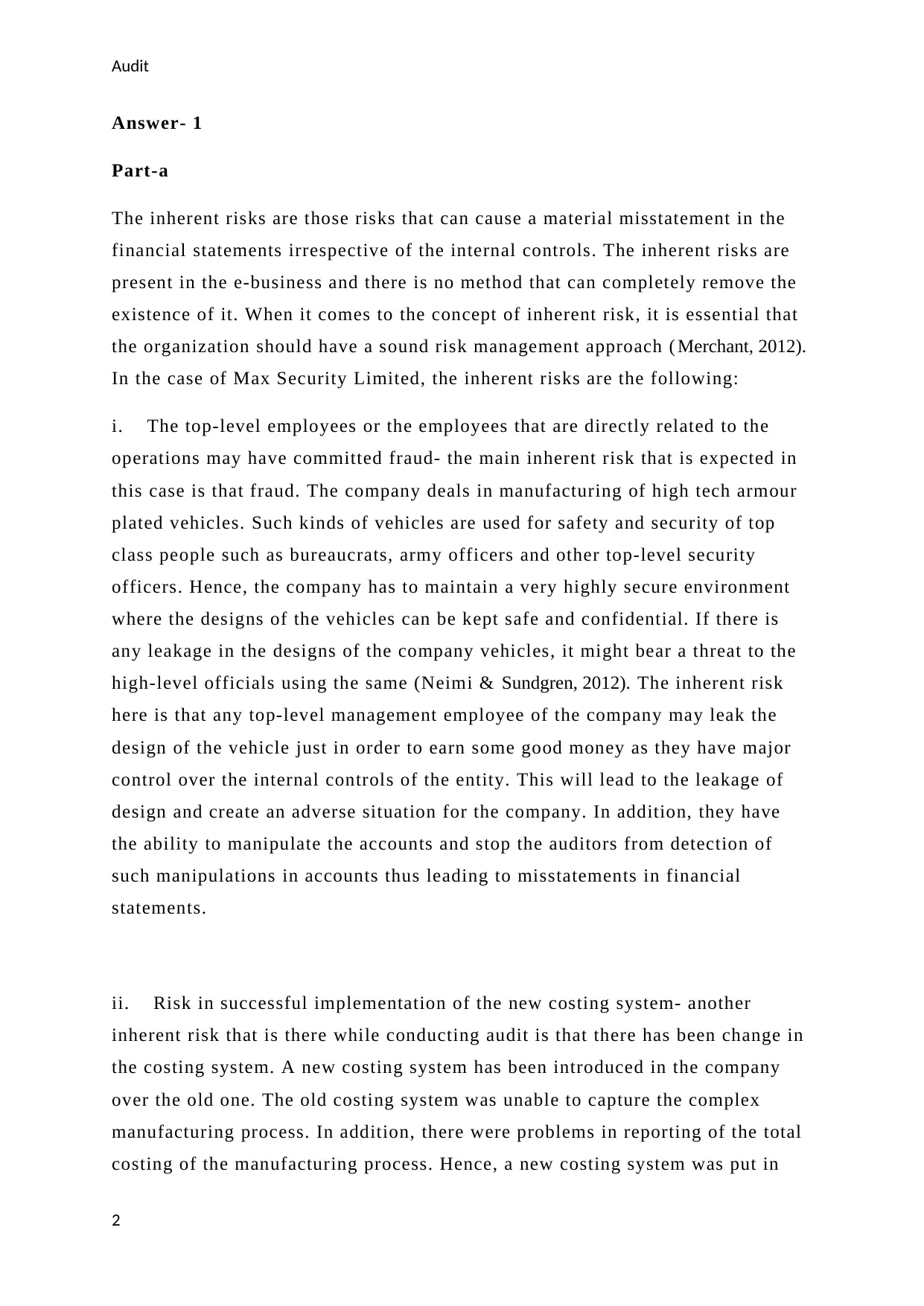
Audit
Answer- 1
Part-a
The inherent risks are those risks that can cause a material misstatement in the
financial statements irrespective of the internal controls. The inherent risks are
present in the e-business and there is no method that can completely remove the
existence of it. When it comes to the concept of inherent risk, it is essential that
the organization should have a sound risk management approach ( Merchant, 2012).
In the case of Max Security Limited, the inherent risks are the following:
i. The top-level employees or the employees that are directly related to the
operations may have committed fraud- the main inherent risk that is expected in
this case is that fraud. The company deals in manufacturing of high tech armour
plated vehicles. Such kinds of vehicles are used for safety and security of top
class people such as bureaucrats, army officers and other top-level security
officers. Hence, the company has to maintain a very highly secure environment
where the designs of the vehicles can be kept safe and confidential. If there is
any leakage in the designs of the company vehicles, it might bear a threat to the
high-level officials using the same (Neimi & Sundgren, 2012). The inherent risk
here is that any top-level management employee of the company may leak the
design of the vehicle just in order to earn some good money as they have major
control over the internal controls of the entity. This will lead to the leakage of
design and create an adverse situation for the company. In addition, they have
the ability to manipulate the accounts and stop the auditors from detection of
such manipulations in accounts thus leading to misstatements in financial
statements.
ii. Risk in successful implementation of the new costing system- another
inherent risk that is there while conducting audit is that there has been change in
the costing system. A new costing system has been introduced in the company
over the old one. The old costing system was unable to capture the complex
manufacturing process. In addition, there were problems in reporting of the total
costing of the manufacturing process. Hence, a new costing system was put in
2
Answer- 1
Part-a
The inherent risks are those risks that can cause a material misstatement in the
financial statements irrespective of the internal controls. The inherent risks are
present in the e-business and there is no method that can completely remove the
existence of it. When it comes to the concept of inherent risk, it is essential that
the organization should have a sound risk management approach ( Merchant, 2012).
In the case of Max Security Limited, the inherent risks are the following:
i. The top-level employees or the employees that are directly related to the
operations may have committed fraud- the main inherent risk that is expected in
this case is that fraud. The company deals in manufacturing of high tech armour
plated vehicles. Such kinds of vehicles are used for safety and security of top
class people such as bureaucrats, army officers and other top-level security
officers. Hence, the company has to maintain a very highly secure environment
where the designs of the vehicles can be kept safe and confidential. If there is
any leakage in the designs of the company vehicles, it might bear a threat to the
high-level officials using the same (Neimi & Sundgren, 2012). The inherent risk
here is that any top-level management employee of the company may leak the
design of the vehicle just in order to earn some good money as they have major
control over the internal controls of the entity. This will lead to the leakage of
design and create an adverse situation for the company. In addition, they have
the ability to manipulate the accounts and stop the auditors from detection of
such manipulations in accounts thus leading to misstatements in financial
statements.
ii. Risk in successful implementation of the new costing system- another
inherent risk that is there while conducting audit is that there has been change in
the costing system. A new costing system has been introduced in the company
over the old one. The old costing system was unable to capture the complex
manufacturing process. In addition, there were problems in reporting of the total
costing of the manufacturing process. Hence, a new costing system was put in
2
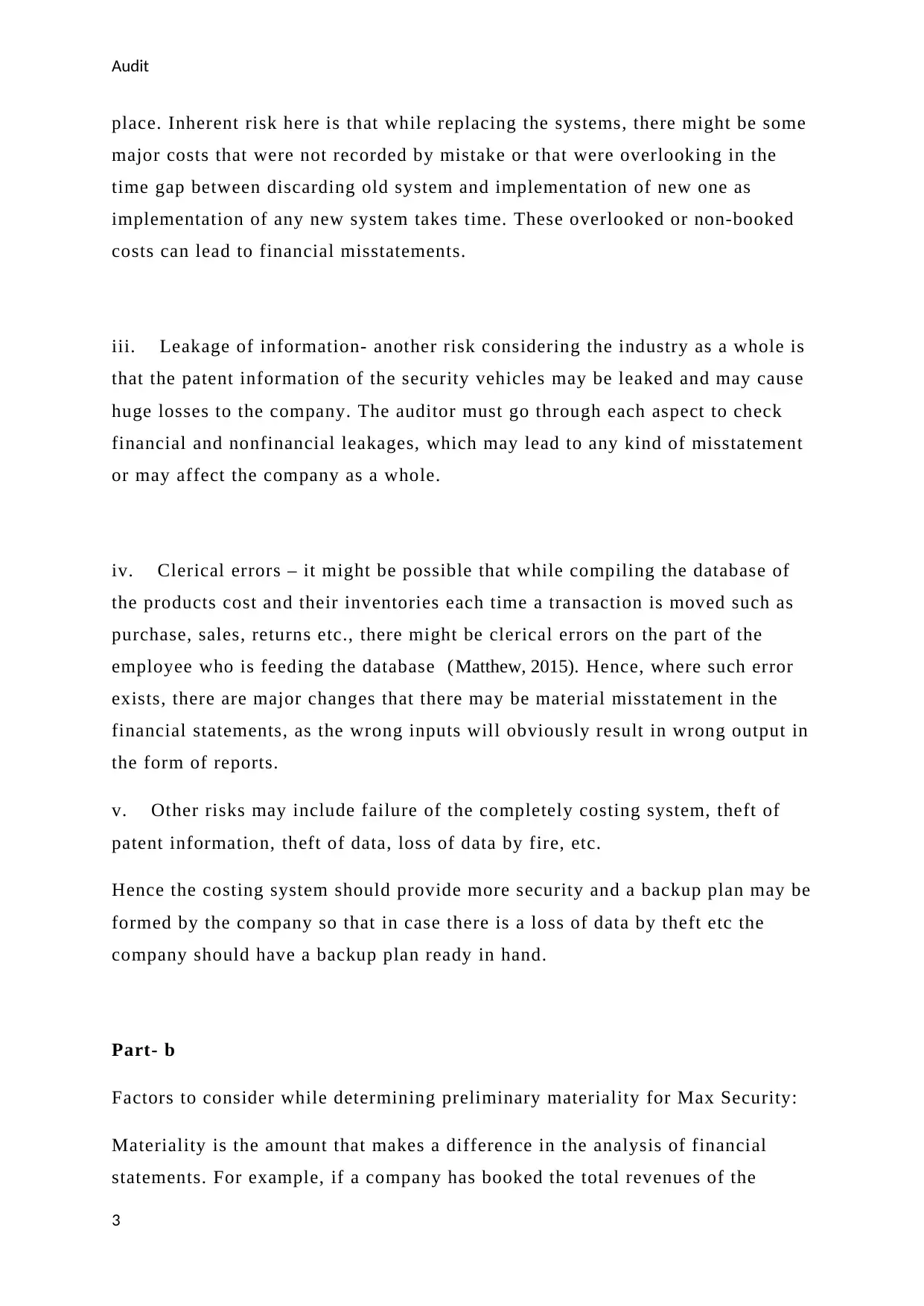
Audit
place. Inherent risk here is that while replacing the systems, there might be some
major costs that were not recorded by mistake or that were overlooking in the
time gap between discarding old system and implementation of new one as
implementation of any new system takes time. These overlooked or non-booked
costs can lead to financial misstatements.
iii. Leakage of information- another risk considering the industry as a whole is
that the patent information of the security vehicles may be leaked and may cause
huge losses to the company. The auditor must go through each aspect to check
financial and nonfinancial leakages, which may lead to any kind of misstatement
or may affect the company as a whole.
iv. Clerical errors – it might be possible that while compiling the database of
the products cost and their inventories each time a transaction is moved such as
purchase, sales, returns etc., there might be clerical errors on the part of the
employee who is feeding the database ( Matthew, 2015). Hence, where such error
exists, there are major changes that there may be material misstatement in the
financial statements, as the wrong inputs will obviously result in wrong output in
the form of reports.
v. Other risks may include failure of the completely costing system, theft of
patent information, theft of data, loss of data by fire, etc.
Hence the costing system should provide more security and a backup plan may be
formed by the company so that in case there is a loss of data by theft etc the
company should have a backup plan ready in hand.
Part- b
Factors to consider while determining preliminary materiality for Max Security:
Materiality is the amount that makes a difference in the analysis of financial
statements. For example, if a company has booked the total revenues of the
3
place. Inherent risk here is that while replacing the systems, there might be some
major costs that were not recorded by mistake or that were overlooking in the
time gap between discarding old system and implementation of new one as
implementation of any new system takes time. These overlooked or non-booked
costs can lead to financial misstatements.
iii. Leakage of information- another risk considering the industry as a whole is
that the patent information of the security vehicles may be leaked and may cause
huge losses to the company. The auditor must go through each aspect to check
financial and nonfinancial leakages, which may lead to any kind of misstatement
or may affect the company as a whole.
iv. Clerical errors – it might be possible that while compiling the database of
the products cost and their inventories each time a transaction is moved such as
purchase, sales, returns etc., there might be clerical errors on the part of the
employee who is feeding the database ( Matthew, 2015). Hence, where such error
exists, there are major changes that there may be material misstatement in the
financial statements, as the wrong inputs will obviously result in wrong output in
the form of reports.
v. Other risks may include failure of the completely costing system, theft of
patent information, theft of data, loss of data by fire, etc.
Hence the costing system should provide more security and a backup plan may be
formed by the company so that in case there is a loss of data by theft etc the
company should have a backup plan ready in hand.
Part- b
Factors to consider while determining preliminary materiality for Max Security:
Materiality is the amount that makes a difference in the analysis of financial
statements. For example, if a company has booked the total revenues of the
3
You're viewing a preview
Unlock full access by subscribing today!
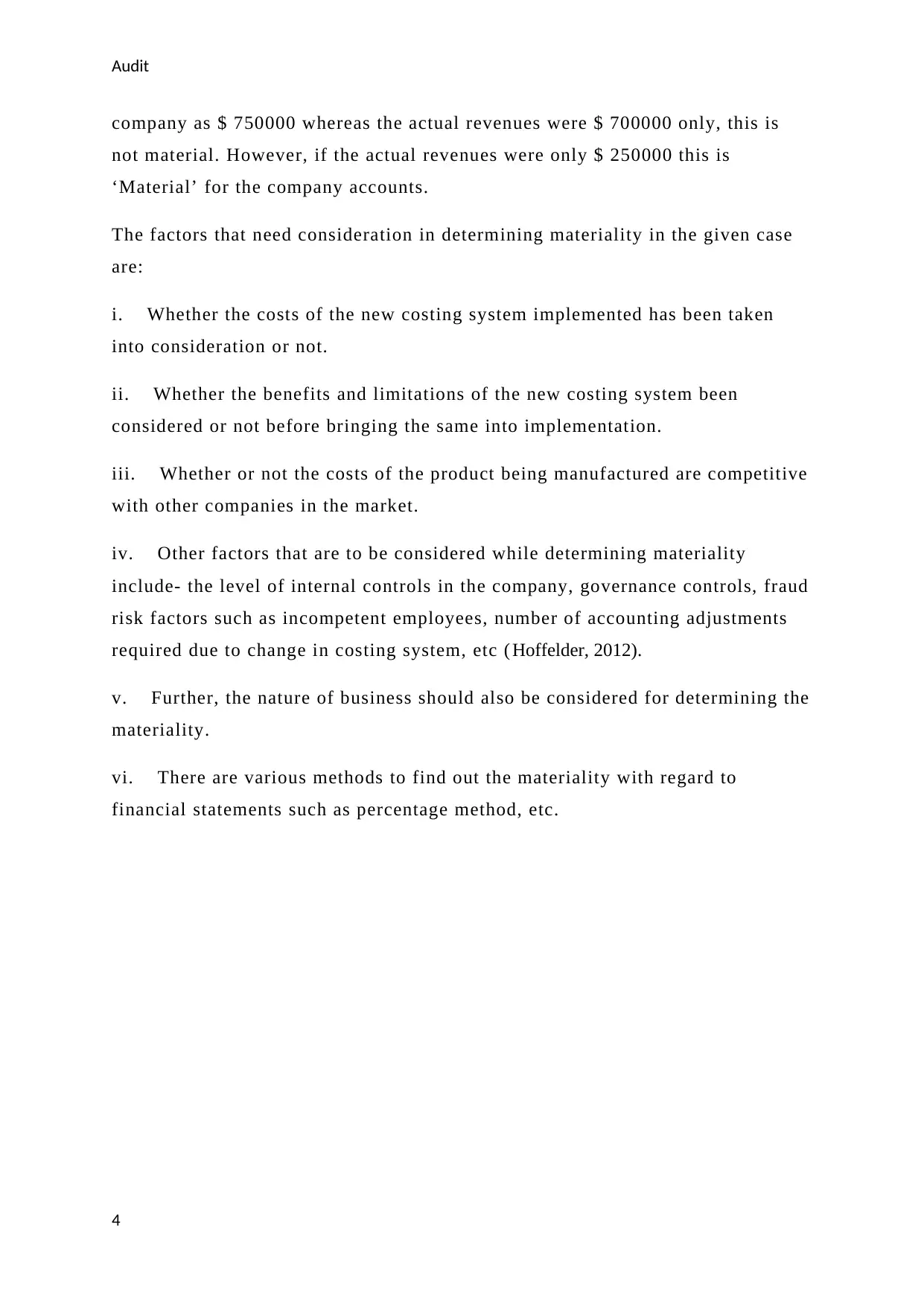
Audit
company as $ 750000 whereas the actual revenues were $ 700000 only, this is
not material. However, if the actual revenues were only $ 250000 this is
‘Material’ for the company accounts.
The factors that need consideration in determining materiality in the given case
are:
i. Whether the costs of the new costing system implemented has been taken
into consideration or not.
ii. Whether the benefits and limitations of the new costing system been
considered or not before bringing the same into implementation.
iii. Whether or not the costs of the product being manufactured are competitive
with other companies in the market.
iv. Other factors that are to be considered while determining materiality
include- the level of internal controls in the company, governance controls, fraud
risk factors such as incompetent employees, number of accounting adjustments
required due to change in costing system, etc ( Hoffelder, 2012).
v. Further, the nature of business should also be considered for determining the
materiality.
vi. There are various methods to find out the materiality with regard to
financial statements such as percentage method, etc.
4
company as $ 750000 whereas the actual revenues were $ 700000 only, this is
not material. However, if the actual revenues were only $ 250000 this is
‘Material’ for the company accounts.
The factors that need consideration in determining materiality in the given case
are:
i. Whether the costs of the new costing system implemented has been taken
into consideration or not.
ii. Whether the benefits and limitations of the new costing system been
considered or not before bringing the same into implementation.
iii. Whether or not the costs of the product being manufactured are competitive
with other companies in the market.
iv. Other factors that are to be considered while determining materiality
include- the level of internal controls in the company, governance controls, fraud
risk factors such as incompetent employees, number of accounting adjustments
required due to change in costing system, etc ( Hoffelder, 2012).
v. Further, the nature of business should also be considered for determining the
materiality.
vi. There are various methods to find out the materiality with regard to
financial statements such as percentage method, etc.
4
Paraphrase This Document
Need a fresh take? Get an instant paraphrase of this document with our AI Paraphraser
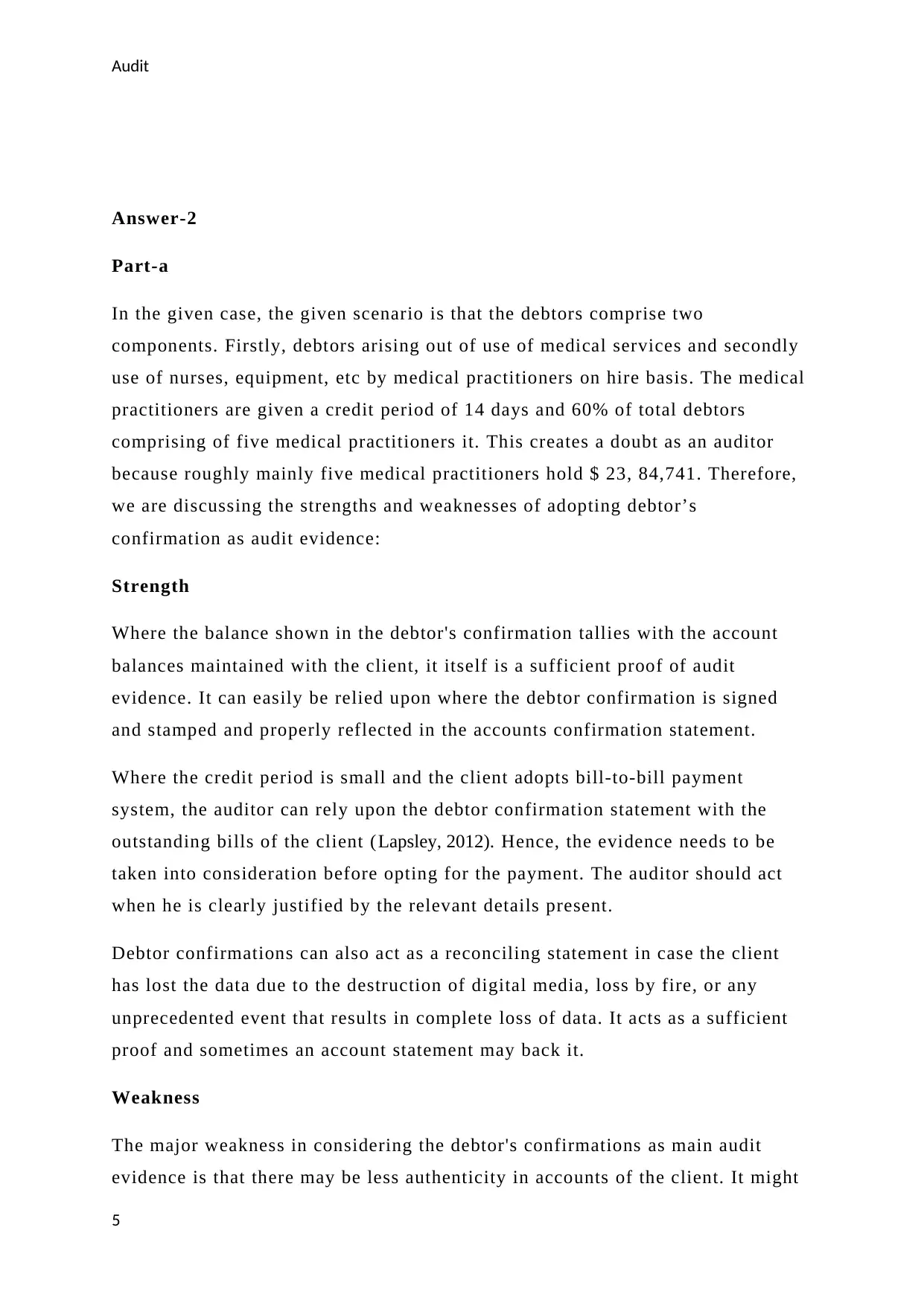
Audit
Answer-2
Part-a
In the given case, the given scenario is that the debtors comprise two
components. Firstly, debtors arising out of use of medical services and secondly
use of nurses, equipment, etc by medical practitioners on hire basis. The medical
practitioners are given a credit period of 14 days and 60% of total debtors
comprising of five medical practitioners it. This creates a doubt as an auditor
because roughly mainly five medical practitioners hold $ 23, 84,741. Therefore,
we are discussing the strengths and weaknesses of adopting debtor’s
confirmation as audit evidence:
Strength
Where the balance shown in the debtor's confirmation tallies with the account
balances maintained with the client, it itself is a sufficient proof of audit
evidence. It can easily be relied upon where the debtor confirmation is signed
and stamped and properly reflected in the accounts confirmation statement.
Where the credit period is small and the client adopts bill-to-bill payment
system, the auditor can rely upon the debtor confirmation statement with the
outstanding bills of the client (Lapsley, 2012). Hence, the evidence needs to be
taken into consideration before opting for the payment. The auditor should act
when he is clearly justified by the relevant details present.
Debtor confirmations can also act as a reconciling statement in case the client
has lost the data due to the destruction of digital media, loss by fire, or any
unprecedented event that results in complete loss of data. It acts as a sufficient
proof and sometimes an account statement may back it.
Weakness
The major weakness in considering the debtor's confirmations as main audit
evidence is that there may be less authenticity in accounts of the client. It might
5
Answer-2
Part-a
In the given case, the given scenario is that the debtors comprise two
components. Firstly, debtors arising out of use of medical services and secondly
use of nurses, equipment, etc by medical practitioners on hire basis. The medical
practitioners are given a credit period of 14 days and 60% of total debtors
comprising of five medical practitioners it. This creates a doubt as an auditor
because roughly mainly five medical practitioners hold $ 23, 84,741. Therefore,
we are discussing the strengths and weaknesses of adopting debtor’s
confirmation as audit evidence:
Strength
Where the balance shown in the debtor's confirmation tallies with the account
balances maintained with the client, it itself is a sufficient proof of audit
evidence. It can easily be relied upon where the debtor confirmation is signed
and stamped and properly reflected in the accounts confirmation statement.
Where the credit period is small and the client adopts bill-to-bill payment
system, the auditor can rely upon the debtor confirmation statement with the
outstanding bills of the client (Lapsley, 2012). Hence, the evidence needs to be
taken into consideration before opting for the payment. The auditor should act
when he is clearly justified by the relevant details present.
Debtor confirmations can also act as a reconciling statement in case the client
has lost the data due to the destruction of digital media, loss by fire, or any
unprecedented event that results in complete loss of data. It acts as a sufficient
proof and sometimes an account statement may back it.
Weakness
The major weakness in considering the debtor's confirmations as main audit
evidence is that there may be less authenticity in accounts of the client. It might
5
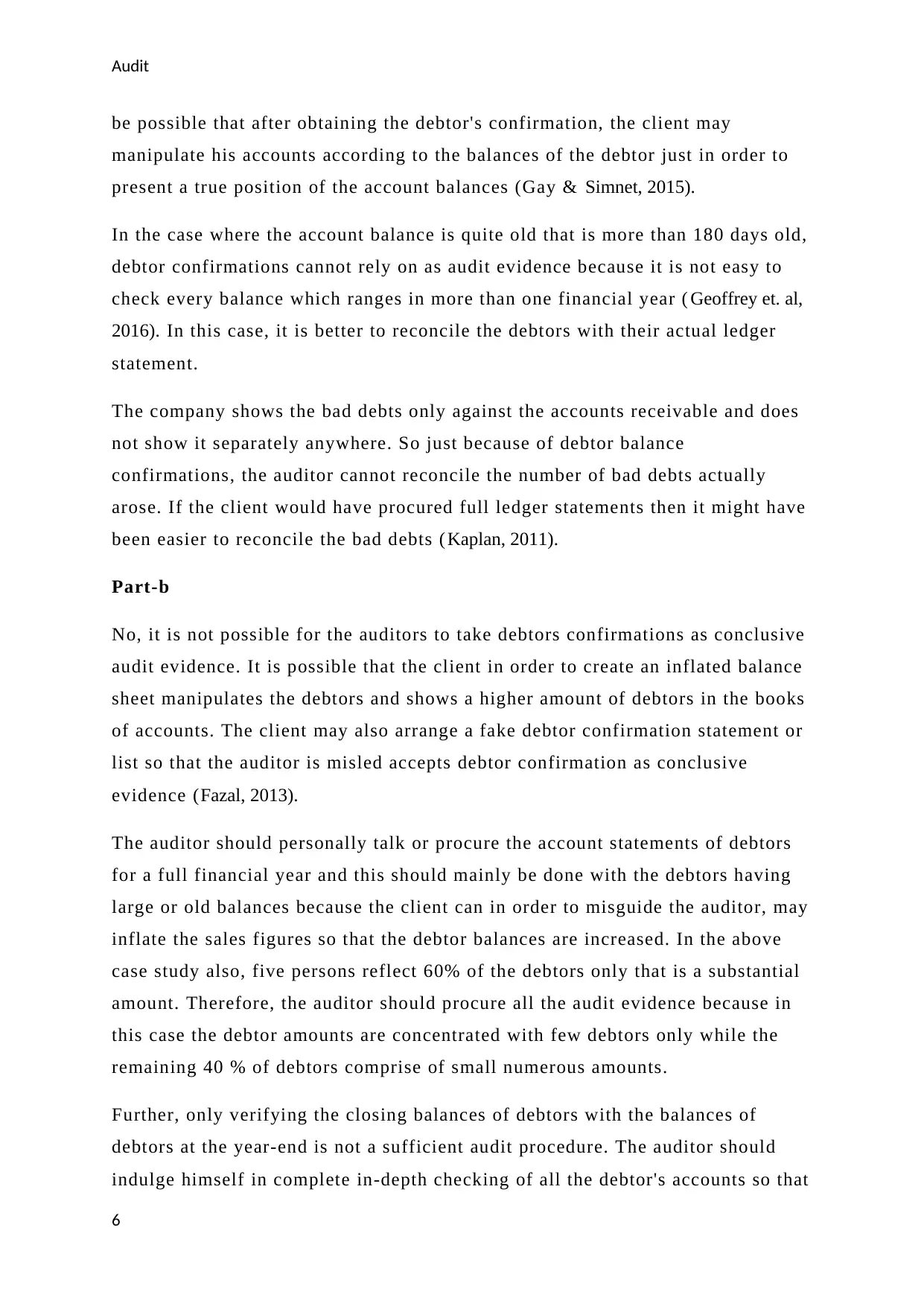
Audit
be possible that after obtaining the debtor's confirmation, the client may
manipulate his accounts according to the balances of the debtor just in order to
present a true position of the account balances (Gay & Simnet, 2015).
In the case where the account balance is quite old that is more than 180 days old,
debtor confirmations cannot rely on as audit evidence because it is not easy to
check every balance which ranges in more than one financial year ( Geoffrey et. al,
2016). In this case, it is better to reconcile the debtors with their actual ledger
statement.
The company shows the bad debts only against the accounts receivable and does
not show it separately anywhere. So just because of debtor balance
confirmations, the auditor cannot reconcile the number of bad debts actually
arose. If the client would have procured full ledger statements then it might have
been easier to reconcile the bad debts ( Kaplan, 2011).
Part-b
No, it is not possible for the auditors to take debtors confirmations as conclusive
audit evidence. It is possible that the client in order to create an inflated balance
sheet manipulates the debtors and shows a higher amount of debtors in the books
of accounts. The client may also arrange a fake debtor confirmation statement or
list so that the auditor is misled accepts debtor confirmation as conclusive
evidence (Fazal, 2013).
The auditor should personally talk or procure the account statements of debtors
for a full financial year and this should mainly be done with the debtors having
large or old balances because the client can in order to misguide the auditor, may
inflate the sales figures so that the debtor balances are increased. In the above
case study also, five persons reflect 60% of the debtors only that is a substantial
amount. Therefore, the auditor should procure all the audit evidence because in
this case the debtor amounts are concentrated with few debtors only while the
remaining 40 % of debtors comprise of small numerous amounts.
Further, only verifying the closing balances of debtors with the balances of
debtors at the year-end is not a sufficient audit procedure. The auditor should
indulge himself in complete in-depth checking of all the debtor's accounts so that
6
be possible that after obtaining the debtor's confirmation, the client may
manipulate his accounts according to the balances of the debtor just in order to
present a true position of the account balances (Gay & Simnet, 2015).
In the case where the account balance is quite old that is more than 180 days old,
debtor confirmations cannot rely on as audit evidence because it is not easy to
check every balance which ranges in more than one financial year ( Geoffrey et. al,
2016). In this case, it is better to reconcile the debtors with their actual ledger
statement.
The company shows the bad debts only against the accounts receivable and does
not show it separately anywhere. So just because of debtor balance
confirmations, the auditor cannot reconcile the number of bad debts actually
arose. If the client would have procured full ledger statements then it might have
been easier to reconcile the bad debts ( Kaplan, 2011).
Part-b
No, it is not possible for the auditors to take debtors confirmations as conclusive
audit evidence. It is possible that the client in order to create an inflated balance
sheet manipulates the debtors and shows a higher amount of debtors in the books
of accounts. The client may also arrange a fake debtor confirmation statement or
list so that the auditor is misled accepts debtor confirmation as conclusive
evidence (Fazal, 2013).
The auditor should personally talk or procure the account statements of debtors
for a full financial year and this should mainly be done with the debtors having
large or old balances because the client can in order to misguide the auditor, may
inflate the sales figures so that the debtor balances are increased. In the above
case study also, five persons reflect 60% of the debtors only that is a substantial
amount. Therefore, the auditor should procure all the audit evidence because in
this case the debtor amounts are concentrated with few debtors only while the
remaining 40 % of debtors comprise of small numerous amounts.
Further, only verifying the closing balances of debtors with the balances of
debtors at the year-end is not a sufficient audit procedure. The auditor should
indulge himself in complete in-depth checking of all the debtor's accounts so that
6
You're viewing a preview
Unlock full access by subscribing today!
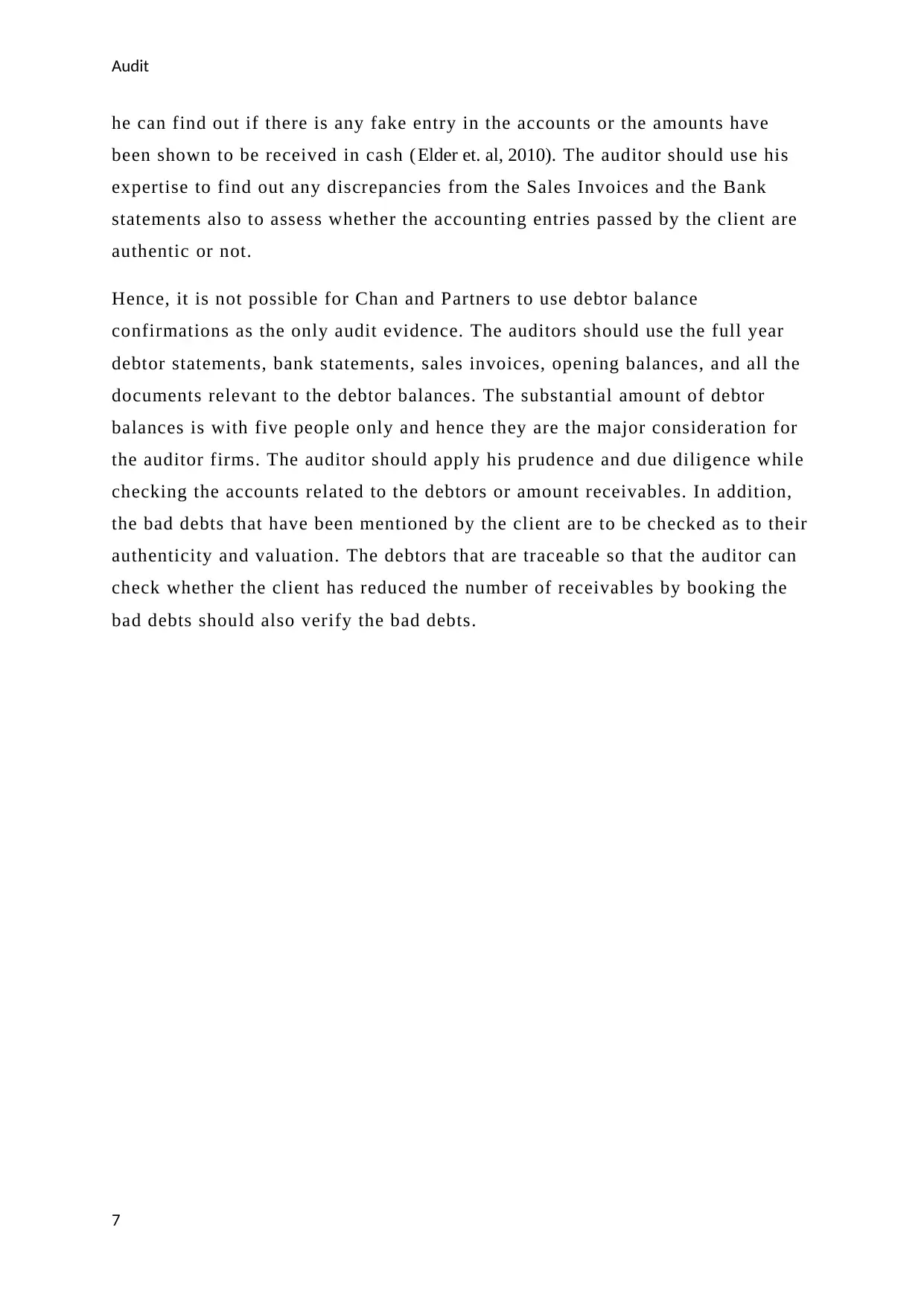
Audit
he can find out if there is any fake entry in the accounts or the amounts have
been shown to be received in cash ( Elder et. al, 2010). The auditor should use his
expertise to find out any discrepancies from the Sales Invoices and the Bank
statements also to assess whether the accounting entries passed by the client are
authentic or not.
Hence, it is not possible for Chan and Partners to use debtor balance
confirmations as the only audit evidence. The auditors should use the full year
debtor statements, bank statements, sales invoices, opening balances, and all the
documents relevant to the debtor balances. The substantial amount of debtor
balances is with five people only and hence they are the major consideration for
the auditor firms. The auditor should apply his prudence and due diligence while
checking the accounts related to the debtors or amount receivables. In addition,
the bad debts that have been mentioned by the client are to be checked as to their
authenticity and valuation. The debtors that are traceable so that the auditor can
check whether the client has reduced the number of receivables by booking the
bad debts should also verify the bad debts.
7
he can find out if there is any fake entry in the accounts or the amounts have
been shown to be received in cash ( Elder et. al, 2010). The auditor should use his
expertise to find out any discrepancies from the Sales Invoices and the Bank
statements also to assess whether the accounting entries passed by the client are
authentic or not.
Hence, it is not possible for Chan and Partners to use debtor balance
confirmations as the only audit evidence. The auditors should use the full year
debtor statements, bank statements, sales invoices, opening balances, and all the
documents relevant to the debtor balances. The substantial amount of debtor
balances is with five people only and hence they are the major consideration for
the auditor firms. The auditor should apply his prudence and due diligence while
checking the accounts related to the debtors or amount receivables. In addition,
the bad debts that have been mentioned by the client are to be checked as to their
authenticity and valuation. The debtors that are traceable so that the auditor can
check whether the client has reduced the number of receivables by booking the
bad debts should also verify the bad debts.
7
Paraphrase This Document
Need a fresh take? Get an instant paraphrase of this document with our AI Paraphraser

Audit
References
Elder, J. R., Beasley S. M., and Arens A. A. (2010). Auditing and Assurance Services. Person
Education, New Jersey: USA
Fazal, H. (2013, May 13). What is Intimidation threat in auditing?.Retrieved from:
http://pakaccountants.com/what-is-intimidation-threat-in-auditing/
Gay, G., and Simnet, R. (2015). Auditing and Assurance Services. McGraw Hill
Geoffrey D. B., Joleen K., K. K.S., and David A. W. (2016). Attracting Applicants for In-
House and Outsourced Internal Audit Positions: Views from External Auditors. Accounting
Horizons, 30(1), 143-156. https://doi.org/10.2308/acch-51309
Hoffelder, K. (2012). New Audit Standard Encourages More Talking. Harvard Press.
Kaplan, R.S. (2011). Accounting scholarship that advances professional knowledge and
practice. The Accounting Review, 86(2), 367–383. https://doi.org/10.2308/accr.00000031
Lapsley, I. (2012). Commentary: Financial Accountability & Management. Qualitative
Research in Accounting & Management, 9(3), pp. 291-292. https://doi.org/10.1111/1468-
0408.00081
Niemi, L., and Sundgren, S. (2012). Are modified audit opinions related to the availability of
credit? Evidence from Finnish SMEs. European Accounting Review, 21(4), 767-796.
https://doi.org/10.1080/09638180.2012.671465
Matthew, S. E. (2015). Does Internal Audit Function Quality Deter Management
Misconduct?. The Accounting Review, 90(2), 495-527. https://doi.org/10.2308/accr-50871
Merchant, K. A. (2012). Making Management Accounting Research More Useful. Pacific
Accounting Review, 24(3), 1-34. https://doi.org/10.1108/01140581211283904
8
References
Elder, J. R., Beasley S. M., and Arens A. A. (2010). Auditing and Assurance Services. Person
Education, New Jersey: USA
Fazal, H. (2013, May 13). What is Intimidation threat in auditing?.Retrieved from:
http://pakaccountants.com/what-is-intimidation-threat-in-auditing/
Gay, G., and Simnet, R. (2015). Auditing and Assurance Services. McGraw Hill
Geoffrey D. B., Joleen K., K. K.S., and David A. W. (2016). Attracting Applicants for In-
House and Outsourced Internal Audit Positions: Views from External Auditors. Accounting
Horizons, 30(1), 143-156. https://doi.org/10.2308/acch-51309
Hoffelder, K. (2012). New Audit Standard Encourages More Talking. Harvard Press.
Kaplan, R.S. (2011). Accounting scholarship that advances professional knowledge and
practice. The Accounting Review, 86(2), 367–383. https://doi.org/10.2308/accr.00000031
Lapsley, I. (2012). Commentary: Financial Accountability & Management. Qualitative
Research in Accounting & Management, 9(3), pp. 291-292. https://doi.org/10.1111/1468-
0408.00081
Niemi, L., and Sundgren, S. (2012). Are modified audit opinions related to the availability of
credit? Evidence from Finnish SMEs. European Accounting Review, 21(4), 767-796.
https://doi.org/10.1080/09638180.2012.671465
Matthew, S. E. (2015). Does Internal Audit Function Quality Deter Management
Misconduct?. The Accounting Review, 90(2), 495-527. https://doi.org/10.2308/accr-50871
Merchant, K. A. (2012). Making Management Accounting Research More Useful. Pacific
Accounting Review, 24(3), 1-34. https://doi.org/10.1108/01140581211283904
8
1 out of 8
Related Documents
Your All-in-One AI-Powered Toolkit for Academic Success.
+13062052269
info@desklib.com
Available 24*7 on WhatsApp / Email
![[object Object]](/_next/static/media/star-bottom.7253800d.svg)
Unlock your academic potential
© 2024 | Zucol Services PVT LTD | All rights reserved.




